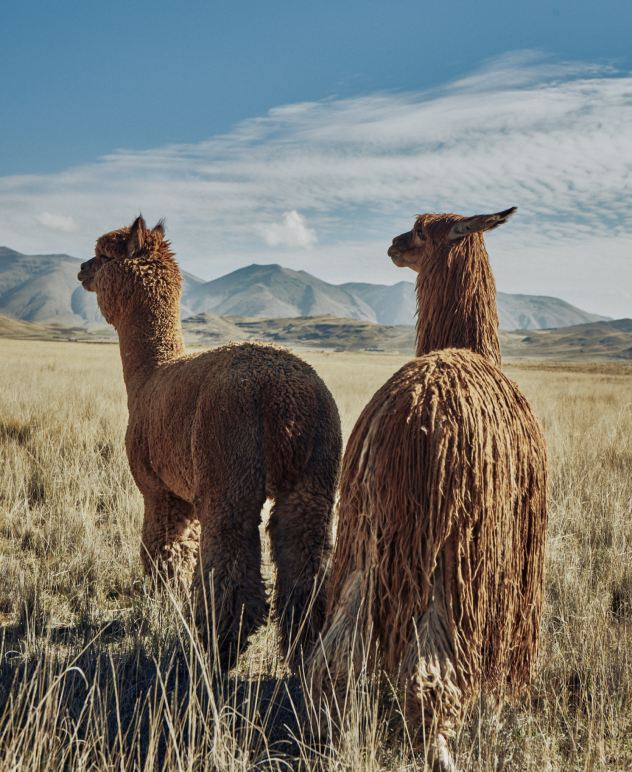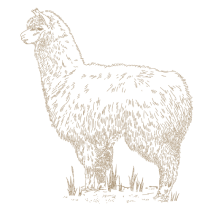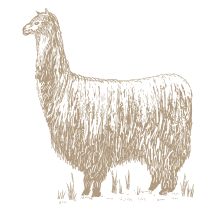The name "alpaca" has become synonymous with fine, high quality wool
used in the elegant world of haute
couture, is one of the warmest as well as
the finest, only surpassed by the vicuña.
The name of the animal in Quecha is allpaka, paqo or paqocha, forms that also appears in the other living language Aimara. Paqo is also used for one particular color of alpaca, a dark coffee- color with a reddish hue, which is considered the original color of all alpacas and even the other camelids.
They range in height from 80-90 cm (2 ft in 3 ft). Their heads are small and rounded, with diminutive ears, large eyes and a sweet expression. The back is slighly curved and the tail hangs down close to the hindquarters.They have a gently rounded profielle with a wide body – more noticeable when viewed from behing- adn dhort legs. Live weight is between 75 and 85 kg (165- 187 lb).
The name "alpaca" has become synonymous with fine, high quality wool
used in the elegant world of haute couture, is one of the warmest as well as the finest, only surpassed by the vicuña.
The name of the animal in Quecha is allpaka, paqo or paqocha, forms that also appears in the other living language Aimara. Paqo is also used for one particular color of alpaca, a dark coffee- color with a reddish hue, which is considered the original color of all alpacas and even the other camelids.
They range in height from 80-90 cm (2 ft in 3 ft). Their heads are small and rounded, with diminutive ears, large eyes and a sweet expression. The back is slighly curved and the tail hangs down close to the hindquarters.They have a gently rounded profielle with a wide body – more noticeable when viewed from behing- adn dhort legs. Live weight is between 75 and 85 kg (165- 187 lb).


Alpaca types
There are two varieties of alpaca: Huacaya and Suri.
Huacaya are almost 90% of present-day herds. They are strong, robust animals whose medium- length fleece has a fluffy appearance. They are resistant to cold and disease and do not mid tough pastures.
Suri are slim and delicate, with long shaggy hair often reaching nearly to the ground. Their young are weak and at birth are affected by the low temperatures and by changes of climate and food.

Alpaca types
There are two varieties of alpaca: Huacaya and Suri.
Huacaya are almost 90% of present-day herds. They are strong, robust animals whose medium- length fleece has a fluffy appearance. They are resistant to cold and disease and do not mid tough pastures.
Suri are slim and delicate, with long shaggy hair often reaching nearly to the ground. Their young are weak and at birth are affected by the low temperatures and by changes of climate and food.

ALPACA HUACAYA

It’s fiber grows, perperdicularly. It has
density, softness, luster and curls with a
spongy appearance.
ALPACA HUACAYA

It’s fiber grows, perperdicularly. It has density, softness, luster and curls with a spongy appearance.
ALPACA SURI

It’s fiber grows parallel to the body, with curls all around them, like fringes, it has a silkier and shinier appearance.
ALPACA SURI

It’s fiber grows parallel to the body, with
curls all around them, like fringes, it has
a silkier and shinier appearance.
Qualities
Alpaca Superfine
- 26-27 microns curly hair fiber. It represents 40% of total alpaca production.
Baby Suri Alpaca
- 22-23 microns long, silky and sparse fiber. It represents 0.5% of total alpaca production.
Baby Alpaca
- 22-23 microns it has 22 natural colors. It represents 25% of total alpaca production.
Royal Alpaca
- 18-19 microns the finest fiber of huacaya. It represents 2% of total alpaca production.
Alpaca 16
- 16 microns has luster and an unbeatable softness to the touch. The fiber from this exclusive selection has a fineness of 16 microns, a world record in Alpaca fiber.
Qualities
Alpaca Superfine
- 26-27 microns curly hair fiber. It represents 40% of total alpaca production.
Baby Suri Alpaca
- 22-23 microns long, silky and sparse fiber. It represents 0.5% of total alpaca production.
Baby Alpaca
- 22-23 microns it has 22 natural colors. It represents 25% of total alpaca production.
Royal Alpaca
- 18-19 microns the finest fiber of huacaya. It represents 2% of total alpaca production.
Alpaca 16
- 16 microns has luster and an unbeatable softness to the touch. The fiber from this exclusive selection has a fineness of 16 microns, a world record in Alpaca fiber.

